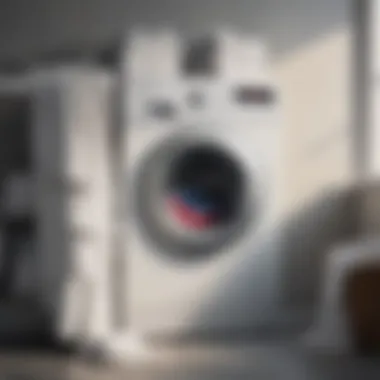Musty Smells in Bathroom Towels: Causes and Solutions


Intro
Towels are a staple in any bathroom, providing comfort and warmth after a bath or shower. However, if they start to develop a musty smell, they can quickly turn from a cozy accessory to a source of embarrassment. Understanding the root causes of these odors is critical for maintaining a clean and inviting space.
In this article, we’ll examine why towels may develop unpleasant odors, the preventative measures that can be taken, and the various cleaning techniques that can restore freshness. Our focus will be on practical insights that housewives and homeowners can integrate into their routines, ensuring that towels smell delightful rather than dank.
Bathroom towels often bear the brunt of moisture, heat, and storage conditions that can lead to those unpleasant musty scents. Below, we will explore the necessary precautions to keep your towels smelling crisp and clean even after repeated use.
Design Inspirations
While the main focus here is on fragrant towels, the aesthetics of your bathroom also play a role in a welcoming atmosphere. A well-designed bathroom where you keep your towels can help set the tone for relaxation and freshness.
- Latest Trends in Bath Design: From minimalistic approaches to vibrant colors, contemporary bathrooms are embracing both functionality and style. Think about incorporating open shelving for towels or hooks that allow for quicker drying. This can significantly minimize musty odors.
- Color Palettes and Themes: Choosing light, airy colors can brighten a bathroom and enhance the feeling of cleanliness. Soft blues, whites, and grays evoke clarity, while deeper hues can add richness. Consider pairing towels with complimentary tones to both suit your decor and promote a fresh vibe.
Causes of Musty Smells in Towels
To tackle musty smells, it’s crucial to identify their origins. Here are several potential culprits:
- Trapped Moisture: Damp towels left in closed spaces don’t have a chance to air out, creating the perfect environment for odor-causing bacteria.
- Fabric Types: Certain materials, like cotton, although soft and absorbent, can retain moisture more than others, making them prone to smells if not dried properly.
- Inadequate Washing: Towels that are not washed often or not cleaned thoroughly can accumulate soap residue and grime, contributing to unpleasant odors.
To maintain freshness, towels should ideally be washed after every three to four uses. If allowed to fester too long, laundry becomes a battleground for odors and bacteria.
Preventative Measures
Now that we’ve identified the problems, let’s explore how to keep musty smells at bay:
- Hang Them Up Properly: After each use, ensure towels hang wide apart to allow for airflow.
- Use A Towel Rack: Opt for a towel rack that supports air circulation instead of crumpling them in a drawer or cabinet.
- Regular Laundering: Create a washing schedule based on the frequency of towel use, maintaining a rotation that keeps them fresh.
Effective Cleaning Strategies
When faced with the inevitable mustiness, here are some tried-and-true methods for rejuvenating your towels:
- Baking Soda and Vinegar Method:
- Hot Water Wash:
- Dry in the Sun:
- Use one cup of baking soda and one cup of vinegar in the wash cycle. This combo works wonders in breaking down odors.
- A hot wash cycle can kill bacteria and lift odors, especially effective if your towels are densely woven.
- Sunlight is a natural deodorizer. After washing, hang towels outside to dry in the sun whenever possible.
Finale
A musty towel is not just a nuisance; it reflects broader hygiene concerns in your bathroom. By understanding the factors contributing to odors and implementing effective cleaning strategies and preventative measures, you can ensure that your towels retain the fresh scent that enhances the overall ambiance of your bath space. Embracing proper care practices will lead to towels that not only feel good but smell great as well.
The Nature of Musty Smells
Understanding musty smells is crucial for keeping our bathroom spaces pleasant and inviting. When those damp odors infiltrate our towels, it’s not just bothersome; it raises questions about hygiene and cleanliness. This article will delve deep into what causes these unpleasant scents and how they can be addressed effectively.
Defining Musty Odors
Musty odors often evoke thoughts of damp basements or forgotten corners of our homes. The term "musty" typically describes a stale, damp, and sometimes moldy smell. This scent can stem from a variety of sources, but in the context of bathroom towels, it primarily indicates that moisture hasn't evaporated properly.
Some might say, "That smells like wet dog!" when they catch a whiff of the unpleasant aroma wafting from towels left damp for too long. This comparison highlights how people associate musty smells with decay or something that has been languishing in an undesirable state. Musty odors also share characteristics with other moldy scents, making it essential to understand their specific origins and implications for our health.
Biology of Odors
Understanding the origins of these odors requires a bit of biology. Musty smells are typically linked to certain types of bacteria and fungi that thrive in moist environments. When towels hang on a rack, still damp after a shower, they create a prime breeding ground for these microorganisms. The longer they remain in this environment, the more they reproduce. These bacteria and fungi release volatile organic compounds (VOCs) as they multiply, which are the true culprits behind the unpleasant smells.
For those who want to eliminate musty odors entirely, it helps to grasp why these organisms thrive. Factors such as humidity, towel material, and even how often you wash them can greatly influence the balance of odor-causing microbes. To paint a clearer picture:
- Humidity: The higher the humidity, the more conducive the environment for mold and bacteria.
- Towel Composition: Certain fabrics, like cotton, hold onto moisture more effectively than synthetic alternatives, making them more prone to musty odors.
- Washing Frequency: Towels that are washed less frequently accumulate more moisture and grime, giving odor-causing microbes the ideal opportunity to thrive.
"A clean towel should feel like a warm hug, not like an old shoe."
As we journey through this article, we will explore the common reasons that contribute to musty towel smells and the practical steps you can take to combat this issue. Through understanding, we can achieve freshness in every corner of our bathrooms.
Common Causes of Musty Smells in Towels
Understanding the common causes of musty smells in towels is a pivotal element in maintaining their freshness and hygiene. Musty odors not only create an unpleasant experience when using towels, but they can also bespeak underlying issues that need addressing, such as poor washing habits or subpar storage conditions. Tackling these issues upfront allows homeowners to enjoy subtler, cleaner linens that contribute to an overall pleasant bathroom environment. Below, we explore the major culprits behind these pesky odors.
Moisture Retention
One of the primary culprits responsible for musty smells in towels is moisture retention. After using towels, especially in humid bathrooms, they often retain excess water, creating a breeding ground for mildew and bacteria. This moisture can seep into the fabric, leading to unpleasant odors that linger long after the towel has been washed.
To keep towels smelling fresh, drying them promptly and thoroughly is critical. Consider hanging them in a way that allows air to circulate freely, rather than in a pile where water can get trapped. Utilizing hooks or towel racks can greatly reduce moisture buildup, ensuring that your towels remain fresh for longer periods.


Type of Fabrics
Not all towel fabrics are created equal when it comes to odor resistance. Cotton, while popular for its softness and absorbency, can also trap odors if not cared for properly. On the other hand, microfiber towels typically have a quicker drying time and, as a result, are less likely to develop mustiness.
Additionally, bamboo towels offer a natural alternative due to their antimicrobial properties, making them less prone to absorbing and holding odors. When choosing towels, it's essential to consider not just the aesthetics and feel but also how the fabric type affects their longevity and odor management.
Improper Drying Techniques
Drying towels incorrectly is a common mistake that can lead to musty smells. While tossing them in the dryer may seem convenient, inadequate drying can trap moisture within the fabric, allowing odors to develop.
When using a washing machine, it's crucial to select the appropriate settings and cycle for towels. High heat can help eliminate moisture, but if your towels are too bulky, they may not dry evenly, leaving some damp spots. If you opt for air drying, ensure they’re hung in a well-ventilated area to promote complete drying.
Storage Conditions
The way towels are stored can also impact their freshness. Storing damp towels in a closed space can lead to musty smells. Even perfectly dry towels can develop odors if they are packed tightly in dark, humid cupboards.
To prevent this, consider using breathable storage options like cotton baskets or linen closets with good airflow. Additionally, avoid stuffing towels into cabinets, allowing space between them. This aids ventilation and helps prolong your towels' freshness.
"The key to fresh towels is to ensure moisture is kept at bay!"
By being mindful of these common causes, you can take significant strides towards maintaining the cleanliness and overall pleasantness associated with your bathroom towels. Each factor contributes uniquely, but collectively addressing them can be incredibly beneficial in keeping odors at bay.
Assessing Towels in Your Bathroom
Assessing the towels in your bathroom can seem like a mundane task, but it plays a crucial role in maintaining a clean and fresh environment. Towels are a significant part of daily hygiene routines, and their condition can directly affect the comfort and health of a space. Recognizing the warning signs of deterioration or odor is essential to ensure your towels serve their purpose without becoming breeding grounds for unpleasant smells.
Evaluating Your Current Towels
Start by inspecting each towel you use. Look for signs of wear such as fraying edges, thinning fabric, or discoloration. These indicators might not just signal a need for replacement, but they also point towards an accumulation of bacteria or mold that can contribute to musty odors. Like it or lump it, an old, musty towel isn’t just unpleasant—it's a hygiene risk.
Make a habit of assessing your towels not only for physical appearance but also for smell. If a towel has an odor that just won't quit, it's time for a serious intervention. Remember, some fabrics hold onto moisture more than others; these are the prime suspects when it comes to mustiness.
Understanding Fabric Types
Not all towels are created equal. The fabric type plays a major role in the overall freshness and longevity of your towels.
Cotton
Cotton is perhaps the most common fabric for towels, and for good reason. It's super absorbent and soft, which makes it feel luxurious against the skin. However, cotton towels can hold onto moisture, which is the double-edged sword of its absorbency. If they're not dried properly after use, they can develop that dreaded musty smell. Cotton is popular for being easy to wash and maintain, but if you don’t follow good drying practices, they can lead to bacterial growth.
Microfiber
Microfiber towels are a game changer in many ways. They're known for their quick-drying capabilities, which helps to reduce the likelihood of developing odors. Their unique construction allows them to pick up dirt and moisture more efficiently than traditional towels. However, while microfiber towels are great for cleanliness, they can end up trapping odors if they aren't cleaned regularly. So while they may not smell musty right off the bat, neglect can lead to issues down the line.
Bamboo
Bamboo towels are becoming increasingly popular. They boast natural antimicrobial properties, which can help in reducing odor from the get-go. Bamboo is known for being both sustainable and soft, making it a comfortable choice as well. However, they may not absorb water as effectively as cotton, which is a consideration if absorbency is a priority for you. To keep bamboo towels fresh, regular cleaning is key, just like with any other fabric type.
Understanding these fabric types informs your choices and care techniques, helping to mitigate potential mustiness and keeping your towels fresh for long. Emphasizing proper care routines aligned with each fabric's properties will inevitably enhance your bath experience.
Preventing Musty Smells in Towels
Keeping towels fresh can sometimes feel like a never-ending battle. Yet, with the right practices, you can avoid that frustrating musty smell from ever creeping in. The focus here is on how simple adjustments to washing and drying can make all the difference. Missing these steps could lead to a basket full of stinky towels.
Best Practices for Washing Towels
When it comes to washing towels, following a few key practices can help maintain their freshness for that cozy feeling when drying off.
Choosing the Right Detergent
Finding the ideal detergent is crucial for preventing musty odors. Certain detergents are formulated specifically for combating mold and mildew, which are common culprits behind those unpleasant smells. A high-efficiency detergent not only cleans but also helps neutralize odors, leaving towels smelling fresh. Unscented varieties can be a beneficial choice for those who have sensitivities to strong fragrances.
One unique feature of these specific detergents is their ability to penetrate deep into the fabric fibers. This ensures that they are breaking down any grime or residue that may lead to unpleasant odors. However, it's important to read labels closely; some detergents might contain essential oils or additives that can affect sensitive skin.
Using Vinegar
Vinegar is another often-overlooked ace in the hole when it comes to laundry. Adding a cup of white vinegar during the rinse cycle can effectively neutralize odors thanks to its natural acidic properties. Vinegar not only helps eliminate mildew and soap build-up but also maintains the color and absorbency of your towels.
Its unique feature lies in the ability to break down the residue that typical detergents might leave behind. That’s why it often turns out to be a standout choice for environmentally conscious individuals, too. Just remember, while vinegar is eco-friendly, it can have a pungent smell itself, so it's best not to use it on delicate fabrics.
Proper Drying Techniques
How you dry your towels can significantly influence whether they smell fresh or musty over time.
Air Drying
Air drying towels can be both economical and effective. Hanging towels outside in the sun not only helps them dry naturally but also harnesses the sun's UV rays, which can kill bacteria. It’s also a great method for those who appreciate sustainability and want to save on energy costs. However, the downside is that in damp climates, it might take longer for towels to dry completely, increasing the risk of odors if not managed well.


Additionally, when towels dry in the open air, they are less likely to trap moisture compared to dryer settings, fostering an environment that's less conducive to unwanted smells.
Machine Drying
Using a dryer is another popular approach, particularly for those who are pressed for time. Machine drying towels is convenient, often leading to soft and fluffy results, which is a big plus. It ensures that towels are dried thoroughly, reducing the chances of mildew forming. However, be mindful of not over-drying, as that can cause damage to the fabric over time and affect absorbency.
Notably, some dryers now come equipped with moisture sensors that can stop the drying process automatically. This feature prevents over-drying and conserves energy, making machine drying a viable choice for modern homes.
"A balance between methods is key. Air drying combined with proper washing can extend towel lifespan and freshness."
By implementing these washing and drying techniques, you can maintain a set of towels that are not only fresh-smelling but also hygienic. Keeping up with regular maintenance today can ensure delightful towels tomorrow!
Effective Cleaning Methods
Addressing musty smells in bathroom towels calls for not just regular cleaning, but also an understanding of effective deep cleaning methods. These techniques not only tackle stubborn odors that cling to fabrics but also enhance overall hygiene. By leveraging specific cleaning solutions and practices, homeowners can help ensure their towels remain fresh and inviting. This section will cover the nuances of deep cleaning techniques, along with tips for routine maintenance, providing a well-rounded approach to towel care.
Deep Cleaning Techniques
Baking Soda Solutions
Baking soda, known chemically as sodium bicarbonate, stands out as an excellent tool for combating musty odors. Its natural deodorizing properties work wonders in neutralizing unpleasant smells that may have absorbed into the fabric over time. When used in washing towels, baking soda contributes to breaking down and eliminating ingrained odors.
One key characteristic of baking soda is its versatility. To tap into its advantages, one might simply add half a cup of baking soda during the washing cycle alongside the usual detergent. This not only enhances cleaning but also boosts the removal of odor-causing bacteria. A unique feature of this solution lies in its non-toxic, eco-friendly nature, making it a safe option for all types of fabrics, especially for those sensitive to strong chemicals.
However, users should keep in mind that while baking soda is effective in odor neutralization, it may not brighten colors as much as other specialized products. Balance these considerations, especially if your towel collection includes vibrant colors.
Oxygen Bleach
Oxygen bleach, a gentle yet powerful cleaning agent, serves as another effective method for tackling musty smells in towels. Unlike its harsher counterpart, chlorine bleach, oxygen bleach is color-safe, making it ideal for maintaining the integrity of fabrics. This product utilizes hydrogen peroxide to release oxygen when mixed with water, providing a deeper clean that eliminates odors at the source.
The primary advantage of oxygen bleach is its ability to disinfect and brighten without the risk of fading colors. Homeowners can use it by following the manufacturer’s instructions, typically adding it during the wash cycle for best results. Its unique feature is its capacity to aid in breaking down organic materials, such as mildew and bacteria, contributing substantially to keeping towels fresh.
However, it’s important to note that certain towel fabrics, like silk or wool, may not respond well. Reading labels and understanding fabric types will help avoid unintended damage, ensuring that the cleaning retains the towels' usability and aesthetic appeal.
Routine Maintenance Tips
To maintain the freshness of bathroom towels, routine care is just as important as deep cleaning. Here are several practical tips:
- Frequent Washing: Regularly washing towels once every three to four uses can prevent accumulating moisture and odors.
- Drying Immediately: Always dry towels promptly after use; damp towels left in a pile can be a breeding ground for smell.
- Proper Folding and Storage: Ensure towels are folded neatly and stored in a well-ventilated space to allow airflow.
- Avoid Overcrowding the Dryer: Ensure there is enough space in the dryer to allow towels to tumble freely; overcrowding can hinder effective drying.
*"Keeping towels fresh involves a blend of regular cleaning and clever storage practices to significantly reduce musty odors."
By implementing these techniques and tips, homeowners can enjoy towels that feel and smell fresh, enhancing the overall bathing experience.
Storage Recommendations
When it comes to keeping your bathroom towels fresh and devoid of musty smells, how you store them plays a crucial role. Many homeowners overlook the impact that storage conditions have on maintaining towel freshness. It’s not just about how often you wash them, but how you let them rest when they’re not in use.
Choosing the Right Storage Space
Identifying the right storage space for your towels is critical. Consider areas that are cooler and less humid to minimize the risk of mildew growth. If your bathroom is small or lacks ventilation, it may be wise to store towels elsewhere. A linen closet with good airflow or a dedicated shelf in a dry bedroom can be ideal alternatives.
Think about these factors when selecting your towel storage space:
- Airflow: Ensure that the space is well-ventilated. A crowded closet can trap moisture.
- Temperature: Keep towels away from heat sources like heaters or radiators, as high temperatures can affect fibers and lead to odors.
- Light Exposure: While it’s essential to keep your towels dry, exposure to too much direct sunlight can degrade certain fabrics over time.
By being thoughtful about where you store your towels, you can significantly decrease the chances of them developing that unwanted musty smell.
Utilizing Breathable Storage Options
Next in line is the type of storage options you use. This directly relates to how breathable the containers or shelves are. Opting for solutions that promote airflow is paramount.
Here are a few tips for utilizing breathable storage options:
- Avoid Plastic Containers: They can trap moisture and lead to an environment where bacteria thrive. Instead, go for natural fabric bags or baskets made of wicker or bamboo.
- Use Towels as an Organizing Tool: Consider rolling your towels instead of folding them. This not only saves space but also allows more air circulation.
- Avoid Overcrowding: As tempting as it is to stuff all your towels into one space, overstuffing can create pockets of moisture. Keep some space between towels to allow them to breathe.
"Proper storage is more than just a convenience; it’s a critical player in maintaining freshness and extending the life of your towels."
Utilizing breathable storage methods and choosing the right space not only elevates the atmosphere of your bathroom but ensures your towels always smell fresh when you reach for them. By paying attention to these elements, you set a strong foundation for a well-maintained, inviting bathroom environment.
Recognizing When to Replace Towels
Determining when to replace your towels is more than just a question of aesthetics; it’s a matter of hygiene and overall bathroom environment. Old towels can harbor harmful bacteria and unpleasant odors, undermining all your efforts at cleanliness. A towel that has outlived its usefulness may do more harm than good, and recognizing the signs can save you both time and frustration in your daily routine.
Signs of Wear and Tear
It’s often easy to overlook the condition of your towels, especially if you’ve bought a bulk set that seems nearly endless. But careful inspection can reveal several tell-tale signs of wear and tear. Here are some key indicators:


- Fading Colors: If your once-vibrant towels look more like a washed-out version of themselves, it might be time to retire them.
- Fraying Edges: When you notice loose threads or rough edges, this is often a sign your towel has reached its limit.
- Lack of Absorbency: If your towels take longer than usual to dry you off or leave you still feeling damp, they’ve lost their functional integrity.
- Persistent Smells: Despite your best washing efforts, if musty odors continue to cling to them, it’s a clear signal they are beyond saving.
Paying attention to these signs will not just enhance your bathing experience but also contribute to a healthier bathroom atmosphere.
Evaluating Efficacy
When considering the efficacy of your towels, think beyond just how they look. Functionality is paramount, especially in a bathroom where moisture is days-in and days-out. Evaluate your towels by asking yourself these questions:
- How well do they perform their main task?
If they no longer absorb water effectively, their primary purpose has been compromised. Consider their fabric type too; cotton, microfibers, and bamboo all have unique lifespans and absorbency levels. - Are they still hygienic?
Old towels can harbor bacteria, mold, or fungi - not what you want near your clean skin. If you’ve noticed unwelcome scents or discoloration, that’s a major signal to replace them. - Do they maintain their shape?
Over time, towels can lose their shape and become less fluffy, making them less pleasant to use. Check if your towels still look and feel inviting. If they resemble a limp rag more than a comforting towel, it might be time to go shopping.
"Investing in fresh towels isn’t a luxury; it’s a necessity for maintaining a clean and welcoming bathroom environment."
Recognizing these factors allows you to make informed decisions about your towel collection, significantly improving your bathing experience and overall home hygiene.
Environmental Factors Influencing Towel Freshness
Understanding how the environment plays a role in towel freshness is crucial for anyone striving to maintain an inviting bathroom. Different conditions can either contribute to or diminish the cleanliness of towels. A well-rounded approach considers humidity, ventilation, and temperature. These factors can influence not only how towels smell but how effective they are in absorbing moisture, ultimately affecting their usability.
Humidity and Its Effects
Humidity, the amount of moisture in the air, is a subtle but powerful player in the game of towel freshness. When humidity levels soar, towels can become breeding grounds for mold and mildew. In a bathroom that lacks adequate air circulation, the water remaining in damp towels may linger longer, creating a damp environment. It’s like leaving a wet sponge in a sealed container—inevitably, you’ll encounter that musty smell.
To manage humidity levels:
- Consider using a dehumidifier if you live in a particularly humid climate.
- After a shower, leave the bathroom door open to facilitate the flow of air.
Being mindful about these little adjustments can make a world of difference in preventing unpleasant odors from building up in towels.
Ventilation Importance
Ventilation goes hand in hand with humidity but also involves the overall airflow within your bathroom. Good ventilation allows the moist air to escape, reducing the chances of towels absorbing this moisture. You might feel you have all the windows shut tightly for comfort, but that could invite trouble in the long run.
A few steps to encourage ventilation include:
- Installing an exhaust fan that can quickly draw out humid air.
- Opening windows during and after shower use can help promote airflow.
Without proper ventilation, towels might remain damp longer than necessary, creating inviting conditions for odor-causing organisms to thrive.
Temperature Control
Temperature control also significantly influences towel freshness. Higher temperatures can accelerate evaporation, thus reducing dampness in towels. On the flip side, cold environments can prolong the drying process, allowing time for musty smells to develop.
To keep towels fresh:
- If you have a heated bathroom or an adjacent room, it can be beneficial to leave towels to dry in that warmer space.
- You may want to avoid keeping towels in drawers or closets that might be cold and damp, as these conditions are just ripe for creating that undesirable odor.
Controlling temperature effectively not only helps in towel maintenance but also contributes to a more pleasant bathing experience.
"Managing the environment can significantly affect how towels smell and function. Pay attention to humidity, airflow, and temperature to keep odors at bay."
By taking these factors into account, you can improve towel longevity and keep your bathroom experience fresh and clean.
Culmination and Final Thoughts
Understanding the cause and solutions for musty smells in bathroom towels isn’t just about keeping things pleasant in your home. It’s tied to hygiene and comfort, which ultimately impacts your wellbeing. Throughout this article, we’ve unraveled the various aspects that contribute to musty odors, from the biology of smells to how environmental conditions play a decisive role.
A well-maintained towel wardrobe not only enhances aesthetic appeal but also promotes good hygiene. No one wants to wrap themselves in a damp and smelly towel after a cozy shower. Regular maintenance and awareness go a long way. Take a moment to consider your towel care routine. Are you doing all you can to ensure their longevity and freshness?
"A little attention today can save a lot of discomfort tomorrow."
Investing effort in understanding and addressing the issues surrounding towel freshness leads to benefits such as:
- Improved overall hygiene in your bathroom
- Enhanced drying experience post-bath or shower
- Increased durability of your towels through informed care practices
Consider the environment and your habits. Adjusting your approach to towel washing, ensuring proper drying, and storing them away from humidity can greatly alleviate those pesky musty smells.
Recap of Key Points
In summary, it pays to be conscious of:
- Moisture retention as a prime cause of odors.
- Different fabric types which affect smell retention.
- Importance of proper drying and storage conditions.
- Utilizing effective cleaning methods regularly is crucial.
- Monitoring environmental factors like humidity and ventilation.
By keeping these elements in mind, anyone can maintain towels that are not only soft but also free from unpleasant odors.
Encouragement for Maintenance
Maintaining freshness in towels requires timely intervention and consistent care. This is not merely about aesthetics, but about creating a sanctuary in your bathroom where you feel rejuvenated.
Here are some habits that can serve you well:
- Wash towels frequently: A weekly wash can prevent odors from building up.
- Air dry when possible: Letting towels breathe in fresh air can do wonders.
- Store them dry: Ensure that they are completely dry before putting them away. Mold thrives where moisture lurks.
- Rotate usage: Don’t stick with the same set for too long; rotate them to give each one a break.
Lastly, don’t hesitate to take a deeper look into your towel maintenance routine. Small adjustments can lead to significant improvements in their freshness. Treat yourself to the comfort of clean, pleasant-smelling towels, and relish the difference they make in your daily life.















